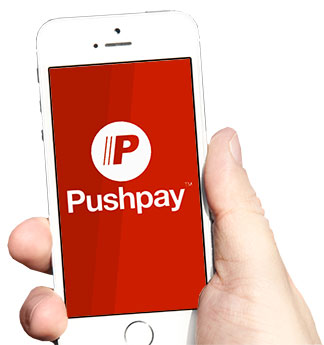
By RaeAnn Slaybaugh
A solid, sustained giving base is crucial for any church. For the church, it implies a steady income stream, usually in the form of weekly, monthly, bimonthly or quarterly gifts.
For members, sustained giving is a means by which they can easily and consistently support the churches they call home.

Although sustained giving is a clear win/win, life happens. Vacations, illnesses or other absences can prevent gifts from being made on Sunday or a check getting into the mail.
Meanwhile, other members are new to giving altogether and want to know how to get started.
The key to establishing a sustained giving base, then, becomes ease of access, speed, simplicity and the ability to communicate with members. Fortunately, a good digital giving platform speaks to all these elements.
Easy. Fast. Simple. Flexible.
Using the Pushpay digital giving platform, the first gift — made by phone, online or even by kiosk — requires a sign-in, which takes about 45 seconds. After that, givers receive a text-message invitation to download an app.
From that point on, gifts can be made via cellphone in 10 seconds or less.
“Everyone has a cellphone now,” explains eChurchGiving U.S. Marketing Director Weston Belkot and Director of Operations Troy Pollock. Based in Redmond, WA, eChurchGiving is the entity bringing the Pushpay giving platform to U.S. churches.
“Our platform ignites spontaneous giving,” they explain. “Individuals can give spontaneously whenever they feel moved to do so — as we all know, cash is being carried far less these days, but people typically always have their smartphones with them.”
 Start internally
Start internally
Before a church seeks to acquaint its members with mobile giving, Belkot and Pollock agree there’s a crucial first step: getting the staff, leaders and volunteers onboard. “They’ll share [the tool] with the volunteers in various departments, at small groups, and so on,” they explain. “We’ve seen this create a ripple effect.”
Moving beyond these influencers, Belkot and Pollock point out that there are only two distinct demographics in a church: those who regularly engage financially and those who have yet to embrace giving.
“For both groups, it all comes back to seeing a change in the heart,” they emphasize. “Our platform is intentionally set up to engage over time — and to remove barriers that may stand in the way of a journey of generosity.”
Fortunately, the likelihood of engaging brand-new givers with a digital giving platform, and getting existing givers to modify their habits, is about equal. Pushpay Chief Marketing Officer Fraser Clark offers up a church client in California as an example. Over a six-month period, 154 church members began using Pushpay. Of those, 87 were existing and intermittent givers. The remainder — 67 — were brand-new givers.
Even so, the aspects of mobile giving that are likely to appeal to each group are unique.
Attracting new givers
Personal communication with givers — especially first-time contributors — is a top-of-mind concern for any church. To this end, the Pushpay platform enables easy sending of thank-you receipts, or more personal emails. “We know that when a person is thanked within 24 hours of a first gift or donation, the likelihood of a subsequent gift is much higher,” Clark points out.
And, engaging with people who don’t regularly contribute, financially, is easier when making a gift is as easy as buying a song on iTunes. “Because of this, we’ve seen churches’ budget increase by upwards of 20 percent,” Belkot and Pollock point out. “In some, as much as 80 percent of the congregation uses our digital giving platform.”
And, in one Chicago church, 90 new givers embraced the digital giving platform within a month — all of whom were brand-new people and profiles.
Not surprisingly, the younger population is particularly receptive to mobile giving. “They’re giving less — maybe because they don’t carry cash and need ease of access,” Clark says. “The habit of generosity is made easier through a tool that fosters it.”
But, the effort is worth it in the long run: According to Clark, those who establish a pattern of generosity in their 20’s are twice as likely to make it a lifelong habit.
 Another appealing option for new givers is the ability to vary the amount of each gift. This is especially attractive to young churchgoers, many of whom don’t always have steady, predictable incomes from week to week.
Another appealing option for new givers is the ability to vary the amount of each gift. This is especially attractive to young churchgoers, many of whom don’t always have steady, predictable incomes from week to week.
“In this respect, we liken Pushpay to having a kiosk in your pocket,” Clark says.
Transitioning existing givers
For members who are already engaged in consistent giving, a mobile platform is a simple way for them to maintain those habits. At The Cause Community Church in Brea, CA, for example, 93 of the 106 members who use Pushpay are regular givers who transitioned to the mobile giving platform.
According to Belkot and Pollock, existing givers are switching, first and foremost, because it frees them from the mundane task of entering their personal details on an envelope every week. Using a mobile giving platform, all they have to do is enter the gift amount.
“To drive sustained giving, you’ve got to put the tools in givers’ hands,” they say. “Our platform remembers their details — including payments — so they can make contributions with less friction.”
This flexibility is also well-suited to members with physical challenges. For example, Belkot and Pollock recently received an email from a church where a member (a consistent giver) has cerebral palsy. “He still gives, and the digital giving platform makes it possible,” the pastor wrote. “He doesn’t even have to fill out an offering envelope.”
The ability to give beyond Sunday is another selling point for existing givers. In fact, Belkot and Pollock say about 40 percent of Pushpay-made gifts are received between Monday and Saturday.
Finally, mobile giving means gifts aren’t limited to how much cash a person is carrying. As Pushpay Chief Marketing Officer Fraser Clark points out, the ability to switch up gift amounts, or to alternate between different payment cards, is another plus.
Elements of mass appeal
Security is a top priority for any type of giver — existing or new — especially in the wake of ongoing financial data breaches affecting major retailers. To this end, Belkot and Pollock point out that Pushpay’s security rivals that of banks; givers are required to enter a 4-digit pin before making a gift.
“And, their 16-digit credit or debit card details aren’t on file with us,” they add — a simple fact that inherently protects against identity theft.
Of course, first things first: A church has to get the congregation onboard with mobile giving in the first place. “Overall, if a church educates its members well, a tool like Pushpay will help them move through ‘flex’ spots of church giving — summer, for example, when so many members go on vacation,” Clark says.
In doing so, Belkot and Pollock point out that the company must be sensitive to each church’s theological approach to giving. At some, the topic of giving is addressed for 10 minutes every Sunday. In others, it’s avoided altogether.
“Regardless of theology, we all can agree that we want to see the body of Christ — the church — resourced,” they explain. “The best way to do that is to make it simple for givers, and that’s what we’ve done with Pushpay.”


